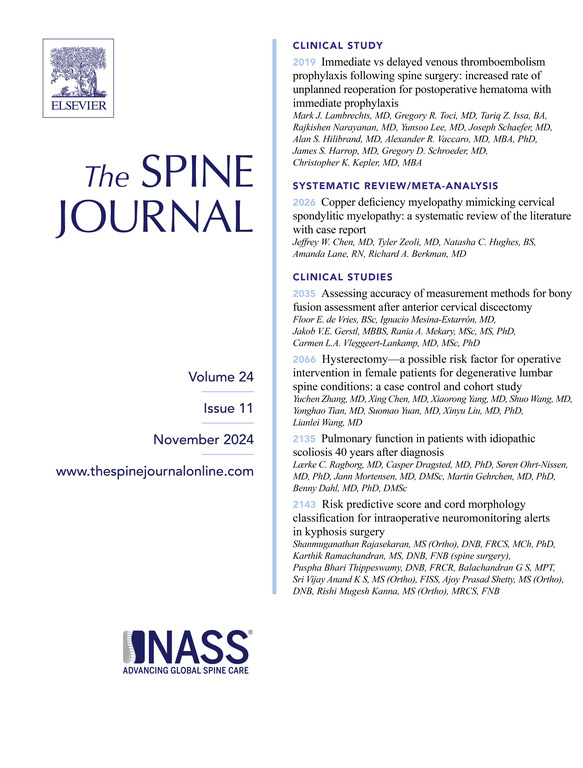Machine learning models for predicting dysphonia following anterior cervical discectomy and fusion: a Swedish Registry Study
IF 4.9
1区 医学
Q1 CLINICAL NEUROLOGY
引用次数: 0
Abstract
BACKGROUND
Dysphonia is one of the more common complications following anterior cervical discectomy and fusion (ACDF). ACDF is the gold standard for treating degenerative cervical spine disorders, and identifying high-risk patients is therefore crucial.
PURPOSE
This study aimed to evaluate different machine learning models to predict persistent dysphonia after ACDF.
STUDY DESIGN
A retrospective review of the nationwide Swedish spine registry (Swespine).
PATIENT SAMPLE
All adults in the Swespine registry who underwent elective ACDF between 2006 and 2020.
OUTCOME MEASURES
The primary outcome was self-reported dysphonia lasting at least 1 month after surgery. Predictive performance was assessed using discrimination and calibration metrics.
METHODS
Patients with missing dysphonia data at the 1-year follow-up were excluded. Data preprocessing involved one-hot encoding categorical variables, scaling continuous variables, and imputing missing values. Four machine learning models (logistic regression, random forest (RF), gradient boosting, K-nearest neighbor) were employed. The models were trained and tested using an 80:20 data split and 5-fold cross-validation, with performance metrics guiding the selection of the best model for predicting persistent dysphonia.
RESULTS
In total, 2,708 were included in the study. Twelve key predictors were identified. Four machine learning models were tested, with the RF model achieving the best performance (AUC=0.794). The most significant predictors across models included preoperative NDI, EQ5Dindex, preoperative neurology, number of operated levels, and use of a fusion cage. The RF model, chosen for its superior performance, showed high sensitivity and consistent accuracy, but a low specificity and positive predictive value.
CONCLUSIONS
In this study, machine learning models were employed to identify predictors of persistent dysphonia following ACDF. Among the models tested, the RF classifier demonstrated superior performance, with an AUC value of 0.790. The RF model identified NDI, EQ5Dindex, and number of fused vertebrae as key variables. These findings underscore the potential of machine learning models in identifying patients at increased risk for dysphonia persisting for more than 1 month after surgery.
预测颈椎前路切除术和融合术后发音障碍的机器学习模型--一项瑞典登记研究。
背景:发音障碍是颈椎前路椎间盘切除融合术(ACDF)后较常见的并发症之一。ACDF是治疗颈椎退行性疾病的金标准,因此识别高风险患者至关重要。目的:本研究旨在评估不同的机器学习模型,以预测ACDF术后持续性发音障碍:研究设计:对瑞典全国脊柱登记处(Swespine)的回顾性研究:2006年至2020年间接受选择性ACDF手术的Swespine登记处所有成年人:主要结果为术后至少持续一个月的自我报告发音障碍。方法:对发音障碍数据缺失的患者进行分析:方法:排除一年随访时发音障碍数据缺失的患者。数据预处理包括对分类变量进行单次编码、对连续变量进行缩放以及对缺失值进行补偿。采用了四种机器学习模型(逻辑回归、随机森林(RF)、梯度提升、K-近邻)。采用 80:20 数据分割和 5 倍交叉验证对这些模型进行了训练和测试,并根据性能指标选择了预测持续性发音障碍的最佳模型:结果:共有 2 708 人被纳入研究。确定了 12 个关键预测因子。测试了四种机器学习模型,其中 RF 模型性能最佳(AUC = 0.794)。各模型中最重要的预测因素包括术前 NDI、EQ5Dindex、术前神经学、手术水平数和融合笼的使用。RF模型因其卓越的性能而被选中,该模型显示出较高的灵敏度和一致的准确性,但特异性和阳性预测值较低:本研究采用机器学习模型来识别 ACDF 术后持续性发音障碍的预测因素。在测试的模型中,RF分类器表现优异,其AUC值为0.790。RF 模型将 NDI、EQ5Dindex 和融合椎体的数量确定为关键变量。这些研究结果凸显了机器学习模型在识别术后发音障碍持续时间超过一个月的高危患者方面的潜力。
本文章由计算机程序翻译,如有差异,请以英文原文为准。
求助全文
约1分钟内获得全文
求助全文
来源期刊

Spine Journal
医学-临床神经学
CiteScore
8.20
自引率
6.70%
发文量
680
审稿时长
13.1 weeks
期刊介绍:
The Spine Journal, the official journal of the North American Spine Society, is an international and multidisciplinary journal that publishes original, peer-reviewed articles on research and treatment related to the spine and spine care, including basic science and clinical investigations. It is a condition of publication that manuscripts submitted to The Spine Journal have not been published, and will not be simultaneously submitted or published elsewhere. The Spine Journal also publishes major reviews of specific topics by acknowledged authorities, technical notes, teaching editorials, and other special features, Letters to the Editor-in-Chief are encouraged.
 求助内容:
求助内容: 应助结果提醒方式:
应助结果提醒方式:


